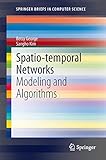Spatio-temporal Networks [electronic resource] : Modeling and Algorithms / by Betsy George, Sangho Kim.
By: George, Betsy [author.].
Contributor(s): Kim, Sangho [author.] | SpringerLink (Online service).
Material type: BookSeries: SpringerBriefs in Computer Science: Publisher: New York, NY : Springer New York : Imprint: Springer, 2013Description: XII, 73 p. 47 illus. online resource.Content type: text Media type: computer Carrier type: online resourceISBN: 9781461449188.Subject(s): Computer science | Database management | Geographical information systems | Graph theory | Computer Science | Database Management | Geographical Information Systems/Cartography | Graph TheoryAdditional physical formats: Printed edition:: No titleDDC classification: 005.74 Online resources: Click here to access online
BookSeries: SpringerBriefs in Computer Science: Publisher: New York, NY : Springer New York : Imprint: Springer, 2013Description: XII, 73 p. 47 illus. online resource.Content type: text Media type: computer Carrier type: online resourceISBN: 9781461449188.Subject(s): Computer science | Database management | Geographical information systems | Graph theory | Computer Science | Database Management | Geographical Information Systems/Cartography | Graph TheoryAdditional physical formats: Printed edition:: No titleDDC classification: 005.74 Online resources: Click here to access online Spatio-temporal Networks: An Introduction -- Time Aggregated Graph - A model for Spatio-temporal Networks -- Shortest Path Algorithms for a Fixed Start Time -- Best Start Time Journeys -- Spatio-temporal Network Applications.
Spatio-temporal networks (STN)are spatial networks whose topology and/or attributes change with time. These are encountered in many critical areas of everyday life such as transportation networks, electric power distribution grids, and social networks of mobile users. STN modeling and computations raise significant challenges. The model must meet the conflicting requirements of simplicity and adequate support for efficient algorithms. Another challenge is to address the change in the semantics of common graph operations, such as, shortest path computation assuming different semantics, or when temporal dimension is added. Also paradigms (e.g. dynamic programming) used in algorithm design may be ineffective since their assumptions (e.g. stationary ranking of candidates) may be violated by the dynamic nature of STNs. In recent years, STNs have attracted attention in research. New representations have been proposed along with algorithms to perform key STN operations, while accounting for their time dependence. Designing a STN database would require the development of data models, query languages, and indexing methods to efficiently represent, query, store, and manage time-variant properties of the network. The purpose of Spatio-temporal Networks: Modeling and Algorithms is to explore this design at the conceptual, logical, and physical level. Models used to represent STNs are explored and analyzed. STN operations, with an emphasis on their altered semantics with the addition of temporal dimension, are also addressed.


There are no comments for this item.